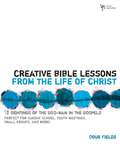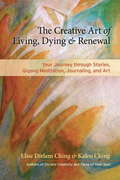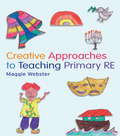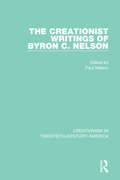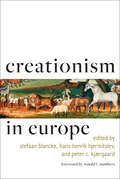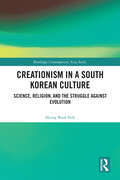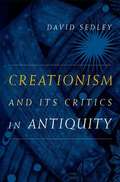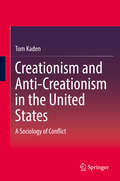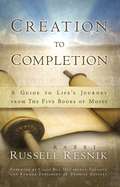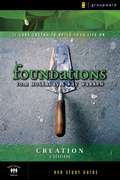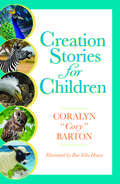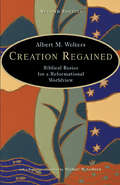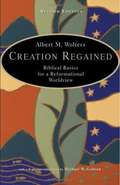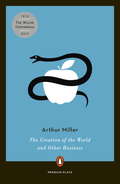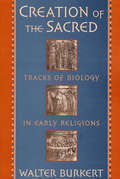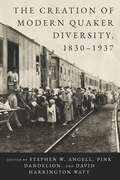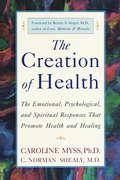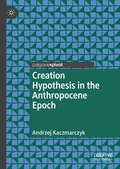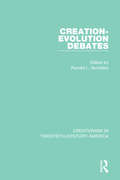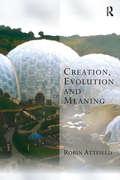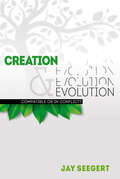- Table View
- List View
Creative Bible Lessons from the Life of Christ: 12 Ready-to-Use Bible Lessons for Your Youth Group (Creative Bible Lessons)
by Doug FieldsDo you want to teach solid Biblical truth to your kids without their eyes glazing over as soon as you say "open your Bibles"? Now you can, with Creative Bible Lessons on the Life of Christ. Veteran youth worker and Bible teacher Doug Fields has crafted 12 lively, ready-to-use lessons that actually make it fun to dig into Scripture. Fields utilizes creative learning techniques to spark your kids' interest and keep them actively involved in each lesson, including: - Learning games . . . - Hilarious handouts - Art projects anyone can do . . . Challenging simulations - Thought-provoking worksheets . . . - Skits and role-plays These techniques are built into clear, easy-to-use lessons that keep your kids active as they absorb the Biblical truth of each lesson. Fields also provides you with a brief teaching outline in each lesson that you can present to bring the message home. Best of all, these lessons are so complete, they require very little preparation time. You'll be able to build quality, creative Bible teaching into your busy schedule -- with Creative Bible Lessons on the Life of Christ. 12 lessons.
The Creative Art of Living, Dying, and Renewal
by Elise Dirlam Ching Kaleo ChingTapping the tremendous healing power of Qigong and the expressive arts, this beautiful book invites the reader to contemplate the continuum of living, dying, and renewal within this life and beyond. The stories, Qigong meditations, and journaling/art processes, including collage and maskmaking, are invitations for you to engage them for your own healing, transformation, and wisdom. Authors, artists, healers, and teachers of Qigong and art, Elise and Kaleo Ching draw on their 23 years of experience working with others on their paths of personal transformation to present an approach to living and dying that is saturated with wisdom, compassion, and understanding. Through their work, the authors have witnessed many personal journeys of dying, transformation, rebirth--facing terminal illness or loss of a loved one, letting go of old lifestyles and embracing new, connecting with past lives and future dreams. The stories and processes in this book will inspire a wide range of people interested in using Qigong practices and meditations, journaling, and art for self-cultivation, mindfulness, spiritual awareness, and healing: artists, clergy, spiritual seekers, psychotherapists, hypnotherapists, social workers, chaplains, hospice workers, teachers, students and practitioners of transformative, shamanic, and healing arts.From the Trade Paperback edition.g Reflection Questions: Chris' Story / Conversation with Chris / Journaling Reflection Questions: Transformation and Your Life's Purpose / Guided Journey: Your Inner Sanctuary and Guide / Journaling and Art: Your Inner Sanctuary and Guide / Jessica: Courting Death / Reflections on Jessica's Story / Journaling Reflection Questions: Jessica's Story / Conversation with Jessica / Journaling Reflection Questions: Your Experience of Suicide / Journaling and Art: The Dance of Death and Life / Journaling Reflection Questions: Your Experience of Past Lives / Journaling and Art: Your Personal Chain of Being / Journaling and Art: Your Spiritual AutobiographyPart Two: Creativity and Your Pilgrimage. Why Create Art? / Kaleo: Aysel / Kaleo: Jean-Paul / Journaling: You and Creativity / Journaling: Creativity and Your Lineage / Death and Rebirth Cycles in Life / Elise: Teekkona / Journaling: Your Recent Experience of Loss / Journaling and Art: Your Death/Rebirth Map / Life/Death Guided Journey and Collage / Guided Journey and Collage 1: Your Life Review / Guided Journey and Collage 2: Looking over the Threshold / Sacred Awareness Guided Journey and Collage / Guided Journey and Collage: Your Mandala of Sacred Awareness / Your Personal Oracle Cards / Guided Journey and Collage: Your Personal Oracle / Journaling and Collage: What Is Dying and What Is Being Born in You Today? / Journaling and Art: Your Oracle Card Vessel / Your Changing Face / Guided Journey and Art: Your Changing Face / Selected Bibliography / Books / Films / The Authors / Illustrations / Bea: Song of the Heart / Elizabeth: Mask of My Father / Transition / Tomoko: Dialogue with Self / Rashidah: Spirit MaskFrom the Trade Paperback edition.
Creative Approaches to Teaching Primary RE
by Maggie WebsterAs an increasingly significant aspect of primary teaching, Creative Approaches to Teaching Primary RE is the essential companion to help bring creativity to life in the classroom. The text begins with a discussion of creative education and the value of Religious Education, moving on to reflect on the cross-curricular nature of the subject, exploring ways of introducing creativity to the classroom, through the medium of Religious Education. Each chapter provides ideas and activities demonstrating how pedagogy and theory can be applied in practice within a school setting. The inclusion of case studies will help you consider how to develop creative approaches in all curriculum areas. This book invites you to ask questions such as:· What is Creative Education?· Why should RE be included in the ever-changing curriculum?· How can I use Religious Education to generate a more creative environment in the classroom?
The Creationists
by Ronald M. NumbersNumbers' examination of the English-speaking Christians, primarily North American, who believe that there was no life on earth before Eden--less than ten thousand years ago--with an emphasis on how persons and parties have used "science" and "pseudoscience" to further their ends.
The Creationist Writings of Byron C. Nelson
by Paul NelsonOriginally published in 1995 this is the fifth volume in the series Creationism in 20th Century America. It re-publishes After Its Kind – a critique on theories of biological evolution and a defense of the biblical account of creation which Nelson wrote when he was a Pastor in New Jersey where he also attended classes in genetics and zoology at Rutgers university. His 1931 volume The Deluge Story in Stone: A History of the Flood Theory of Geology, also reprinted here was continuously in print until the 1960s. As his scientific and theological correspondence expanded in the wake of his publications, Nelson became further involved in the ‘evolution debates’. During the late 1930s his writings concentrated on early man and the glacial phenomena he saw all about him in Wisconsin and he compiled the materials he thought necessary to relate Scripture to the evidence of human antiquity.
Creationism in Europe (Medicine, Science, and Religion in Historical Context)
by Stefaan Blancke, Hans Henrik Hjermitslev, and Peter C. KjærgaardAmerican creationists’ efforts to export their beliefs have succeeded in Europe beyond their own expectations, winning followers across creed and country.For decades, the creationist movement was primarily situated in the United States. Then, in the 1970s, American creationists found their ideas welcomed abroad, first in Australia and New Zealand, then in Korea, India, South Africa, Brazil, and elsewhere—including Europe, where creationism plays an expanding role in public debates about science policy and school curricula. In this, the first comprehensive history of creationism in Europe, leading historians, philosophers, and scientists narrate the rise of—and response to—scientific creationism, creation science, intelligent design, and organized antievolutionism in countries and religions throughout Europe.Providing a unique map of creationism in Europe, the authors chart the surprising history of creationist activities and strategies there. Over the past forty years, creationism has spread swiftly among European Catholics, Protestants, Jews, Hindus, and Muslims, even as anti-creationists sought to smother its flames. Antievolution messages gained such widespread approval, in fact, that in 2007 the Parliamentary Assembly of the Council of Europe passed a resolution advising member states to "defend and promote scientific knowledge" and "firmly oppose the teaching of creationism as a scientific discipline on an equal footing with the theory of evolution." Creationism in Europe offers a discerning introduction to the cultural history of modern Europe, the variety of worldviews in Europe, and the interplay of science and religion in a global context. It will be of interest to students and scholars in the history and philosophy of science, religious studies, and evolutionary theory, as well as policy makers and educators concerned about the spread of creationism in our time.
Creationism in a South Korean Culture: Science, Religion, and the Struggle against Evolution (Routledge Contemporary Asia Series)
by Hyung Wook ParkPark investigates the unexpected success of early Korean creationists, who were mostly scientists, and argues that creationism is not a product of the lack of intelligence or proper scientific education but a consequence of more profound social developments in the twentieth and twenty-first centuries.Known as the religious belief rejecting evolutionary theory, creationism has become a global issue. Although it was often known as a problem unique among fundamentalist Protestants in the United States, it has been appropriated by people with diverse religions around the world, including Asia, Africa, Europe, and South America. Many scientists and educators perceive this dissemination as a threat to modern pedagogy and scholarship, although few of them are aware of its historical and cultural contexts. Through an intensive study of the birth and growth of the anti-evolutionary movement in South Korea during the twentieth and early twenty-first centuries, this book traces an important part of this worldwide movement against evolution. The author argues that South Korean creationism started from the country's past as a developmental state during the Cold War but proliferated further amid subsequent democratization and globalization. Creationism reflected the new identifications of some Korean scientists and engineers with evangelical faith, who actively formed their own domain outside of the state hegemony and authority.This book is a valuable reference for scholars interested in the dynamic interaction between science and religion in East Asia.
Creationism and Its Critics in Antiquity
by David N. SedleyThe world is configured in ways that seem systematically hospitable to life forms, especially the human race. Is this the outcome of divine planning, or simply of the laws of physics? Ancient Greeks and Romans famously disagreed on whether the cosmos was the product of intelligent design or of accident. In Creationism and its Critics in Antiquity, David Sedley examines this question and illuminates new historical perspectives on the pantheon of thinkers who laid the foundations of western philosophy and science. Versions of what today we call the "creationist" option were widely favored by the major thinkers of classical antiquity, including Plato, whose ideas on the subject prepared the ground for Aristotle's celebrated teleology. But Aristotle himself excluded any role for divine intervention, in this respect aligning himself with the anti-creationist lobby, whose most militant members--the atomists--sought to show how a world just like ours would inevitably form by sheer accident, given only the infinity of space and matter. This stimulating study explores seven major thinkers or philosophical movements who were enmeshed in the debate: Anaxagoras, Empedocles, Socrates, Plato, the atomists, Aristotle, and the Stoics. An epilogue considers their debate from the viewpoint of Galen, the great second-century A. D. doctor, who was also a leading voice of creationism. Adapted from Sedley's 2004 Sather Lectures at the University of California, Berkeley, this the first book-length study of an old debate.
Creationism and Anti-Creationism in the United States: A Sociology of Conflict
by Tom KadenThis book deals with professional creationist and anti-creationist organizations in America, and describes how the “conflict between science and religion” is the result of the interaction between these two groups. It retraces their history from the 1960s onwards, and identifies crucial turning points that led to new forms of creationism and anti-creationism. It explains their strategies, labels and arguments as effects of this history and structure. Taking a field theoretical approach, the book avoids problems of prior creationism research, making it possible to identify the mechanisms through which creationism generates new strategies, arguments, and media output. The field model is used as an interpretive tool to make sense of some of the most important creationist and anti-creationist publications and media statements.
Creation to Completion: A Guide to Life’s Journey from The Five Books of Moses
by Rabbi Russell ResnikA commentary on each of the weekly portions read in traditional synagogues, a practice seen in the New Testament.
The Creation Study Guide: 11 Core Truths to Build Your Life On
by Kay Warren Tom HolladayThe Foundations small group DVD series helps Christians connect the truths of the Bible with the realities of their lives. Used and refined for years as an integral part of Saddleback Church’s discipleship program, this powerful, innovative resource is designed to correct the frequent disconnect between what we say we believe as Christians and how we actually live. Tom Holladay and Kay Warren each teach two of the four sessions on the eleven small group DVDs. The corresponding participant’s guides provides space for taking notes, lively discussion questions and focuses on a core truth of Christianity. Choose the topics you and your group wish to explore … and discover the key that can • strengthen beliefs to change behavior • lessen your day-to-day stress level • increase your security in an insecure world • help you raise your kids with a right perspective on life • increase your love for and trust in God Individual small group DVDs include • The Bible • God • Jesus • The Holy Spirit • Creation • Salvation • Sanctification • Good and Evil • The Afterlife • The Church • The Second Coming
Creation Stories for Children
by Cory BartonCory Tails is a collection of charming stories about lovable creatures from God's creation that help teach Katie and Jeffrey principles and values as they face challenges in their young lives. Along the way they meet Silly Millie Moose, Peter Proud Peacock, Flash the Firefly and many others. Cory Tails is not merely a book of stories but a tool to help parents instill the Christian principles and values of obedience, self-esteem, kindness, compassion, temperament, trust, and faith in their own children's lives as they enjoy the adventures and antics of these endearing characters.
Creation Regained: Biblical Basics for a Reformational Worldview (Biblical Classics Library #No. 21)
by Albert M. Wolterswith a Postcript coauthored by Michael W. GoheenIn print for two decades and translated into eight languages, Albert Wolters's classic formulation of an integrated Christian worldview has been revised and expanded to reach new readers beyond the generation that has already benefited from this clear, concise proposal for transcending the false dichotomy between sacred and secular. Wolters begins by defining the nature and scope of a worldview, distinguishing it from philosophy and theology. He then outlines a Reformed analysis of the three basic categories in human history -- creation, fall, and redemption -- arguing that while the fall reaches into every corner of the world, Christians are called to participate in Christ's redemption of all creation. This Twentieth Anniversary edition features a new concluding chapter, coauthored with Michael Goheen, that helpfully places the discussion of worldview in a broader narrative and missional context.
Creation Regained: Biblical Basics for a Reformational Worldview
by Albert M. Wolters Michael W. GoheenIn this brief and straightforward examination of Christians' basic beliefs, Albert M. Wolters spells out the structure of a reformational worldview and its significance for those who seek to follow the Scriptures. Wolters begins by defining the nature and scope of a worldview, distinguishing it from philosophy or theology, and noting that the Christian community has advanced a variety of worldviews. He then outlines a Reformed analysis of the three fundamental turning points in human history -- Creation, the Fall, and Redemption -- concluding that while the Fall might reach into every corner of the world, Christians are called to participate in Christ's redemption of all creation.
The Creation of the World and Other Business
by Arthur MillerA master dramatist's humorous retelling of the biblical creation story as a parable for our time Breathing new life into timeless biblical tales, Arthur Miller charmingly reimagines the Book of Genesis from the temptation of Adam and Eve to the fraternal tragedy of Cain and Abel. In the beginning, God, generally satisfied with his creation, is nonetheless perplexed by Adam and Eve--why won't they multiply? It takes wily Lucifer to interest them in anything more than playing handball in the Garden of Eden, but their new knowledge comes at a price. The first family is exiled from paradise--just as Lucifer is banned from heaven--and a fallen, morally ambiguous state becomes the destiny of humankind. Though The Creation of the World and Other Business was Arthur Miller's first Broadway comedy, it is full of the searching insight and sparkling dialogue that distinguish his best dramas.
Creation of the Sacred: Tracks of Biology in Early Religions
by Walter BurkertSacrifice—ranging from the sacrifice of virgins to circumcision to giving up what is most valued—is essential to all religions. Could there be a natural, even biological, reason for these practices? Something that might explain why religions of so many different cultures share so many rituals and concepts? In this extraordinary book, one of the world’s leading authorities on ancient religions explores the possibility of natural religion—a religious sense and practice naturally proceeding from biological imperatives. Because they lack later refinements, the earliest religions from the Near East, Israel, Greece, and Rome may tell us a great deal about the basic properties and dynamics of religion, and it is to these cultures that Walter Burkert looks for answers. His book takes us on an intellectual adventure that begins some 5,000 years ago and plunges us into a fascinating world of divine signs and omens, offerings and sacrifices, rituals and beliefs unmitigated by modern science and sophistication. Tracing parallels between animal behavior and human religious activity, Burkert suggests natural foundations for sacrifices and rituals of escape, for the concept of guilt and punishment, for the practice of gift exchange and the notion of a cosmic hierarchy, and for the development of a system of signs for negotiating with an uncertain environment. Again and again, he returns to the present to remind us that, for all our worldliness, we are not so far removed from the first Homo religiosus. A breathtaking journey, as entertaining as it is provocative, Creation of the Sacred brings rich new insight on religious thought past and present and raises serious questions about the ultimate reasons for, and the ultimate meaning of, human religiousness.
The Creation of Quaker Theory: Insider Perspectives
by Pink DandelionThe last forty years has witnessed a 'golden age' of Quaker Studies scholarship, with the bulk of this work into the history and sociology of Quakerism being undertaken by scholars who are also Quakers. For the scholars involved, their Quakerism has both prompted their research interests and affected their lives as Quakers. This book presents a unique study into Quakerism: it draws together the key theories of Quaker origins, subsequent history, and contemporary sociology, into a single volume; and it allows each of the contributors the opportunity to reflect on what led to the initial choice of research topic, and how their findings have in turn affected their Quaker lives. The result is a unique contribution to Quaker theory as well to the discussion on insider/outsider research. This book is invaluable to anyone interested in Quakerism, research into religion, notions of outsider objectivity within academia, and areas of theology, religious history and sociology in general.
The Creation of Modern Quaker Diversity, 1830–1937 (The New History of Quakerism)
by Stephen W. Angell, Pink Dandelion, and David Harrington WattThe period from 1830 to 1937 was transformative for modern Quakerism. Practitioners made significant contributions to world culture, from their heavy involvement in the abolitionist and women’s rights movements and creation of thriving communities of Friends in the Global South to the large-scale post–World War I humanitarian relief efforts of the American Friends Service Committee and Friends Service Council in Britain.The Creation of Modern Quaker Diversity, 1830–1937 explores these developments and the impact they had on the Quaker religion and on the broader world. Chapters examine the changes taking place within the denomination at the time, including separations, particularly in the United States, that resulted in the establishment of distinct branches, and a series of all-Quaker conferences in the early twentieth century that set the agenda for Quakerism. Written by the leading experts in the field, this engaging narrative and penetrating analysis is the authoritative account of this period of Quaker history. It will appeal to scholars and lay Quaker readers alike and is an essential volume for meeting libraries. In addition to the editors, the contributors include Joanna Clare Dales, Richard Kent Evans, Douglas Gwyn, Thomas D. Hamm, Robynne Rogers Healey, Julie L. Holcomb, Sylvester A. Johnson, Stephanie Midori Komashin, Emma Jones Lapsansky, Isaac Barnes May, Nicola Sleapwood, Carole Dale Spencer, and Randall L. Taylor.
The Creation of Health: The Emotional, Psychological, and Spiritual Responses that Promote Health and Healing
by Caroline Myss C. Norman ShealyA collaboration between a traditionally trained physician and a medical intuitive,The Creation of Healthilluminates the deep connection between emotional dysfunction and physical illness. It describes the role that emotional disturbances play in the most common diseases and ailments from the common cold to arthritis, diabetes, heart disease, and cancer. After providing an introduction to intuitive medicine and its history, method of diagnosis, and relationship to traditional medicine, Myss and Shealy detail the deeper emotional and psychic reasons why illness develops in the body. Dr. Shealy offers a traditional account of a particular disease or ailment, while Dr. Myss sheds light on the deeper causes through her corresponding energy analysis. Confirming the link between illness and emotion,The Creation of Healthputs forth a groundbreaking vision of holistic healing. From the Trade Paperback edition.
The Creation of Eve and Renaissance Naturalism
by Greenstein Jack M.Depicting the Creation of Woman presented a special problem for Renaissance artists. The medieval iconography of Eve rising half-formed from Adam's side was hardly compatible with their commitment to the naturalistic representation of the human figure. At the same time, the story of God constructing the first woman from a rib did not offer the kind of dignified, affective pictorial narrative that artists, patrons, and the public prized. Jack M. Greenstein takes this artistic problem as the point of departure for an iconographic study of this central theme of Christian culture. His book shows how the meaning changed along with the form when Lorenzo Ghiberti, Andrea Pisano, and other Italian sculptors of the fourteenth and fifteenth centuries revised the traditional composition to accommodate a naturalistically depicted Eve. At stake, Greenstein argues, is the role of the artist and the power of image-making in reshaping Renaissance culture and religious thought.
Creation Myths of America
by Jeremiah CurtinThis book was written in 1895 and is a collection of creation myths of the Wintu and Yana peoples of northern California.
Creation Hypothesis in the Anthropocene Epoch
by Andrzej KaczmarczykThis book is a discourse on creation hypothesis in light of new scientific findings made in the 20th and 21st centuries, incorporating sacred texts of different religions. It also addresses the universal phenomena of information and mathematics within this context. The discourse makes an important contribution to the ongoing conversation about creationism, intelligent design, and the problems of science vs. religion.
Creation-Evolution Debates
by Ronald L. NumbersOriginally published in 1995, Creation-Evolution Debates is the second volume in the series, Creationism in Twentieth Century America, reissued in 2021. The volume comprises eight debates from the early 1920s and 1930s between prominent evolutionists and creationists of the time. The original sources detail debates that took place either orally or in print, as well as active debates between creationists over the true meaning of Genesis I. The essays in this volume feature prominent discussions between the likes of Edwin Grant Conklin, Henry Fairfield Osbourne and William Jennings Bryan, John Roach Francis and Charles Francis Potter, George McCready Price and Joseph McCabe and William Bell Riley versus Charles Smith, amongst many others. The collection will be of especial interest to natural historians, and theologians as well as academics of philosophy, and history.
Creation, Evolution and Meaning (Transcending Boundaries in Philosophy and Theology)
by Robin AttfieldThis book presents the case for belief in both creation and evolution at the same time as rejecting creationism. Issues of meaning supply the context of inquiry; the book defends the meaningfulness of language about God, and also relates belief in both creation and evolution to the meaning of life. Meaning, it claims, can be found in consciously adopting the role of stewards of the planetary biosphere, and thus of the fruits of creation. Distinctive features include a sustained case for a realist understanding of language about God; a contemporary defence of some of the arguments for belief in God and in creation; a sifting of different versions of Darwinism and their implications for religious belief; a Darwinian account of the relation of predation and other apparent evils to creation; a new presentation of the argument from the world's value to the purposiveness of evolution; and discussions of whether or not meaning itself evolves, and of religious and secular bases for belief in stewardship.
Creation & Evolution
by Jay SeegertThis is a controversy that goes beyond mere facts discover what makes the difference! Is there real evidence for either side in this controversy? Why does the past or the issue of origins matter if you are a Christian? Creation, evolution, intelligent design, theistic evolution -- are these views compatible? Do the questions of creation, evolution, and the Bible seem to be too complicated and confusing? Do you want to know more about why the issue remains one for the Church today, yet don't want to end up reading mind-numbing details? Whatever your stance on this issue, you will find Creation & Evolution to be both interesting and easy to understand. Presenting the best information on both sides of the debate, the book takes you on a fascinating discovery of the issues and their relevance to your faith. With an engaging style, diverse points, and numerous quotes of interest, the book is a fast-track guide to understanding why God is found in the details of this critical debate.
